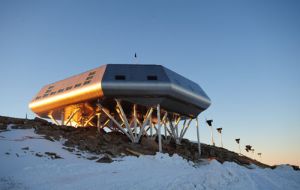MercoPress. South Atlantic News Agency
Zero-emission, energy self sufficient Antarctic base
 The Princess Elisabeth station
The Princess Elisabeth station Belgium opened a new 20 million Euro “zero emissions” polar science station in Antarctica on Sunday, returning to the continent to study climate change 42 years after closing its first base there.
The Princess Elisabeth research hub is totally energy self-sufficient and also aims not to emit any carbon dioxide emissions, according to the Belgian-based International Polar Foundation that runs the base. The octagonal, spaceship-like base sits on stilts on a ridge a few kilometres north of the Soer Rondane Mountains. It will focus on analyzing nearby deep ice shelves. The station's roof is covered by solar panels, designed to provide part of the energy needed to run the isolated post. Other energy sources will come from large wind turbines. The six kilowatt Scottish manufactured small wind turbines are designed to operate in average winds of 53mph, but have been proven to withstand temperatures of -60 degrees Celsius and wind gusts of over 200mph. The high winds mean the turbines are expected to deliver the highest output of any small-scale wind system in the world, providing 230V of electricity for the station's heating, IT equipment, lights and scientific instruments. According to the Scottish suppliers the composite materials allow the blades to bend and flex in strong winds. The blades flexibility means that as winds get stronger they twist to reduce aerodynamic efficiency, regulating their speed to prevent damage to the turbine and allowing them to continue operating and generating output in the type of storms that would result in conventional turbines being turned off. The base is expected to have a lifespan of 25 years and will conduct research in climatology, glaciology and microbiology. Teams of scientists, including glaciologists, are already at work there from Belgium, Japan, France, Britain and the United States. The station was inaugurated Sunday by Belgian Defence Minister Pieter De Crem and other government officials. "It is really important that as a small country we can show our participation in large international efforts here in Antarctica," De Crem told VRT television from Antarctica. Maaike Van Cauwenbergh, from the Belgian Science Policy Office, said the base is in an isolated area "where there has been little research done." She said it cost 20 million Euro to build and is located in a vast 1,000-kilometer zone between the Russian and Japanese research stations. "The Princess Elisabeth station attests that there is growing public interest in projects carrying a message of sustainable development, especially in terms of energy management," the polar group said in a statement. "The conception of a 'zero emission' building capable of standing up to the extreme conditions in the Antarctic goes to show that similar techniques can also be deployed in more temperate areas of the world," it added. The prefabricated station took two years to move from Belgium to the South Pole, where it was rebuilt.




Top Comments
Disclaimer & comment rulesCommenting for this story is now closed.
If you have a Facebook account, become a fan and comment on our Facebook Page!